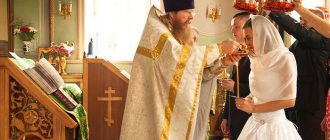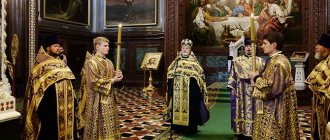Question from Archpriest Valentin Mordasov’s book “What do you recommend, Father”: Are lay people allowed to read prayers from the Breviary for Clergy?
Priest's answer:
Valentin (Mordasov)
archpriest
Lay people, except priests and deacons, are allowed to read prayers from the Breviary. For example, there are such remote places where there is no church; there the believers themselves perform an incomplete funeral service, that is, they sing the stichera, read the canon, the Apostle, but do not read the Gospel, the prayer of permission, and do not say the exclamations and litanies of the priest and deacon. They even perform services in this way; for example, they serve not mass, but lunch service.
The Trebnik is a liturgical book that sets out the order of services, that is, sacraments and other sacred actions that are performed by the Russian Orthodox Church on special occasions, and which are not part of ordinary church services.
A breviary is a liturgical book that sets out the order of various requirements.
The breviary got its name from the word “treba”, which means sacrifice.
The book got its name from the word “treba”, which in the ancient Russian language meant sacrifice, sacrifice. Currently, this is a book of prayer and sacred rites, which is performed at the request of one or more Christians. Usually these conversions occur in special circumstances of life.
Read the missal on azbyka.ru
This book contains such sacraments as prayer services, memorial services, funeral services, lighting of houses, etc. This does not include the sacrament of the Eucharist and ordination.
When did the missal begin to exist? All the rites that are described in the breviary go back to the time of the apostolic life of the church.
Of course, the very original missals have not reached our times. But from the earliest known sources, the Euchologion of Bishop Sarapion of Tmuit has reached us, as well as a small collection of prayers and services, which are contained in chapter 8 of the apostolic decrees.
This is what the rather dilapidated Euchologion looks like, surviving to our times.
Until the 9th century, the number of prayers gradually increased. For example, in the Greek church, together with the service books, they compose one book, and it is called Euchologion, in our language a prayer book.
It is also worth noting that manuscripts from the 8th and 9th centuries have survived to this day. It was the Euchologion of the Barberine Library and the Euchologion of the Sinai Monastery, which were found by Bishop Porfiry. At that time he went on a trip to the East.
The breviary is written in Church Slavonic and in Russian
To begin with, it is worth noting what types of missals are there? The Breviary is available in Church Slavonic and Russian.
The breviary was first translated into Slavic by the holy brothers Cyril and Methodius in the 9th century.
The breviary was first translated into Slavic by the holy brothers Cyril and Methodius in the 9th century.
This missal was in use until the time of Grand Duke Ivan Danilovich Kalita. Under this great prince, a certain Greek Theognostus, who was appointed Metropolitan of All Russia, decided in 1328 to translate the missal he brought into Slavic. His missal came into general use in the Russian Orthodox Church.
The Greek Theognostus, who was appointed Metropolitan of All Russia, decided in 1328 to translate the missal he brought into Slavic
Soon, in 1564, book printing began in Rus', and it was then that the first handwritten missals began to be published under Patriarchs Philaret, Joseph, Nikon, and Joachim.
One of the patriarchs decided to supplement the breviary with an appendix of conciliar decrees. But the breviary, which was published under Patriarch Joseph in 1651, was called the Great Breviary. Then, after him, Joseph the Second decided to publish an abbreviated version of the large missal. It was called small.
In 1687, Patriarch Joachim decided to slightly improve these publications by printing the nomocanon in an abbreviated form in the small breviary. Also in 1863, in the Kiev-Pechersk Lavra, Metropolitan Arseny of Kiev blessed the publication of an additional breviary. This is exactly the story of the creation of this book.
In 1863, in the Kiev-Pechersk Lavra, Metropolitan Arseny of Kiev blessed the publication of an additional breviary
Origin story
The history of the breviary begins in apostolic times, when for the conduct of divine services certain records of prayers were created, which were read on special occasions. The first books of this nature did not reach modern times and were lost or lost until the formation of the Christian Church.
The earliest example is a collection of prayers recorded by Bishop Euchologion of Tmuite. His notes are part of the collection "Apostolic Constitutions" and are found in the eighth volume. Historians suggest that this document was compiled in the 4th century in Egypt, where the bishop lived.
As the Church grew and its services and sacraments expanded, the number of prayers performed on special occasions increased until the 9th century. For convenience, they were written down and unique collections of prayers were obtained, which were read in certain situations.
All the rites described in the breviary appeared in apostolic times
In Greece, at the same time as the missal, the Prayer Book or Euchologion was compiled and written down. Manuscripts from the 8th–9th centuries, which were compiled and recorded in Barberini and the Sinai monastery, have survived to this day.
On the territory of the CIS, the missal appeared in the 9th century after it was translated by Cyril and Methodius into the Old Church Slavonic language. This version of the compiled prayer books was preserved and used during services until the reign of John Kalita.
Already under this Grand Duke, Metropolitan Theognost of Kiev gave the order to compile a new translation, which the Metropolitan personally brought to Kievan Rus in 1328. Subsequently, this particular version of the book was used everywhere in Russia, Ukraine and other Slavic states in Orthodox churches.
Over the following centuries, especially with the development of printing, missals were rewritten, supplemented and corrected. Each new patriarch made his own adjustments to the collection:
- Filaret (1619−1633).
- Joasaph (1634−1640). Under this patriarch, the collection began to include an appendix of the Council Resolutions.
- Joseph (1642 - 1652). After all the adjustments and additions, the released copy began to be called Large.
- Nikon (1652 - 1666).
- Joasaph II (1667 - 1672). This husband released an abbreviation that later became known as Small.
- Joachim (1674 - 1690) included the Nomocanon in the collection.
The last correction was made in 1863 under Metropolitan Arseny and with his blessing, it was published in printed form and was called the Additional Trebnik. Additions and adjustments to the first editions have led to the fact that today the most complete and high-quality collection of all prayers is used in worship.
In church practice there are large, small, additional and small missals in two parts
So, in church practice there are these types of missal: large, small, additional and small in two parts. Let's look at each of them in more detail.
Great Breviary - consists of 2 parts. The first part of the textbook contains the sequence of such sacraments as baptism, confirmation, wedding, consecration of oil, repentance and other divine services. Also the burial of the dead, the blessing of water, the tonsure of monks.
Necessary things for the wedding of newlyweds, among which we see a missal with the sacrament of wedding
It is with these prayers that the Russian Orthodox Church meets a person at his birth, and also illuminates him for the future life, when he moves into eternity. This refers to the sacrament of baptism and the sacrament of burial.
Complete morning prayer rule in Church Slavonic
About the living
Remember, Lord Jesus Christ, our God, your mercy and generosity from all eternity, for whose sake you became human, and crucifixion and death, for the salvation of those who believe in you, you endured you deigned;
and rose from the dead, you ascended into heaven and sit at the right hand of God the Father, and listen to the humble prayers of those who call upon you with all their hearts:
incline Your ear and hear the humble prayer of me, Your unnecessary servant, into the stench of the spiritual fragrance that is offered to You for all Your people.
And first of all, remember Your Holy, Catholic and Apostolic Church, which You have provided with Your honest Blood, and established, and strengthened, and expanded, multiplied, died, and invincible hell preserve the new gates forever;
Calm the tearing apart of the Churches, quench the pagan vacillations, and quickly destroy and eradicate the heresies of rebellion, and turn them into nothingness by the power of Your Holy Spirit. (Bow)
Save, Lord, and have mercy on our God-protected country, its authorities and army, protect their power with peace, and subdue under the nose of the Orthodox every enemy and adversary, and the words peaceful and good in the hearts them about Your Holy Church, and about all Your people:
Let us live a quiet and silent life in orthodoxy, and in all piety and purity. (Bow)
Save, Lord, and have mercy on the Great Lord and Father of our Holiness Patriarch Kirill, Your Reverend Metropolitans, Orthodox Archbishops and Bishops, Priests and Deacons, and the entire congregation of the Church O Lord, you have appointed me to shepherd your verbal flock, and through their prayers have mercy and save me, a sinner. (Bow)
Save, Lord, and have mercy on my spiritual father (his name), and with his holy prayers forgive my sins. (Bow)
Save, Lord, and have mercy on my parents (their names), brothers and sisters, and my relatives in the flesh, and all the neighbors of my family, and others, and grant them Your peaceful and premium goodness. (Bow)
Save, Lord, and have mercy, according to the multitude of Your bounties, all the sacred monks, monks and nuns, and all those living in virginity and reverence and fasting in monasteries, in deserts, in caves, mountains, pillars , closed the clefts of stones, the islands of the sea, and in every place of Your dominion living faithfully, and serving You piously, and praying to You:
ease their burden, and comfort their sorrow, and give them strength and strength to achieve their feat in You, and through their prayers grant me remission of sins. (Bow)
Save, Lord, and have mercy on the old and the young, the poor and the orphans and widows, and those who are in sickness and sorrow, troubles and sorrows, conditions and captivity, dungeons and imprisonments, today in persecution,
For your sake and the Orthodox faith, from the tongues of the godless, from the apostates and from heretics, Thy present servants, and remember, visit, strengthen, comfort, and soon by Thy strength I will weaken, free I will go and deliver them. (Bow)
Save, Lord, and have mercy on those who do good to us, who are merciful and nourishing to us, who gave us alms, and who commanded us unworthy to pray for them, and who give us peace, and show Thy mercy to them, the gift I am everything to them, even for the salvation of the petition, and the perception of eternal blessings . (Bow)
Save, Lord, and have mercy on those sent to serve, those who travel, our fathers and brothers, and all Orthodox Christians. (Bow)
Save, Lord, and have mercy on those who have been tempted by my madness, and who have turned away from the path of salvation and led to evil and inappropriate deeds;
By Your Divine Providence, return the packs to the path of salvation. (Bow)
Save, Lord, and have mercy on those who hate and offend me, and those who create misfortune for me, and do not leave them to perish for my sake, a sinner. (Bow)
Those who have departed from the Orthodox faith and are blinded by disastrous heresies, with the light of Your knowledge, enlighten and Thy Holy Apostles of the Catholic Church. (Bow)
In the breviary - prayers are arranged in a certain sequence
In the breviary, the prayers are arranged in the sequence in which every Christian usually needs them. If a person is sick and this prevents him from coming to church to receive the sacrament of holy communion, the Russian Orthodox Church allows a person to be introduced to the holy mysteries of Christ at home, which is why in the breviary there is such an order “whenever it happens that the sick person will soon be given communion.”
The second part of the large missal contains prayers for various services and religious rituals, these are, for example, prayers for the illumination of things, buildings or structures, as well as, for example, prayer for the illumination of vegetables.
Here you can find prayers for permission from an oath, prayers at the beginning of any work. And also prayers asking for blessings from God. There are also prayers of the seven holy youths of Ephesus for the weak and those who do not sleep.
The second section also contains prayer singing for various occasions. Here are the rites for the consecration of the temple
In this same part of the missal there are some other sequences that relate to public worship - this is the rite of washing the feet on Maundy Thursday, as well as the words of John Chrysostom on Maundy Thursday and Holy Easter.
In the same section there is also prayer singing for various occasions. Here are the rites for the consecration of the temple. Also in the large breviary there are two additional chapters, which seem to constitute the third part of the breviary. The first chapter contains the month book, and the 2nd chapter contains the estates, that is, an index of the names of saints in alphabetical order.
Types and contents
The Breviary was rewritten and supplemented many times, so today there are several versions of this collection. Each of them is used at the discretion of the clergy.
Great Breviary - it consists of 2 parts, which generally contain all the requirements existing in the Russian Orthodox Church. The first part contains prayers for the main church Sacraments (baptism, anointing with chrism, wedding, blessing of oil and repentance), which should occur in a person’s life.
The Great Breviary contains the sequence of all Church Sacraments
These are the most important sacraments that have great spiritual significance in the life of a Christian. The second part covers all other prayer needs that do not have a deep impact on a person’s soul, but are also important to him. In this part you can find prayers:
- for the consecration of land, apartments and other property;
- for the consecration of food and harvest;
- when starting work;
- blessing of Easter treats;
- about expelling evil spirits, etc.
In addition to these texts, in the Great Trebnik you can find instructions for public worship (the ritual of washing the feet on Maundy Thursday, the ritual of acceptance into the Bosom of the Church, the consecration of the temple, etc.). After these parts, the collection contains a collection of canonical rules (Nomocanon) and months with an index of saints.
The Small Trebnik is a shortened version of the Large Book, therefore it contains only slightly shortened Sacraments, sequences for sacred rites and months.
Important! These prayers are most often read by parish priests. The Nomocanon is also included in the collection, but in its most abbreviated version, containing only the main rules.
Additional Breviary - in this collection you can only find the rites of consecration. They are read when blessing the temple cross, vessels for ministry, priest's vestments, icons and other church paraphernalia. In addition to these, there are prayers for the consecration of household items that Christians use at home.
The Breviary of Metropolitan Peter Mohyla was published in 1646. The purpose of publishing this collection was the need to give the Ukrainian people guidance on traditional Orthodox church rituals. The Metropolitan believed that Catholicism had a significant influence on the church, so he created, as he believed, a book of prayers cleared of errors and errors.
Breviary of Metropolitan Peter Mohyla
There are also many different editions of missals, which were published with minor changes and adjustments by the current patriarchs. But they are all extremely similar and contain prayers for the main and minor rites of the church.
Small Breviary - is an abbreviated form of the large
The small breviary is a shortened form of the large breviary. It contains a sequence of sacred rites and prayers, which most often need to be performed by a priest.
The first part of the large breviary was also included in the small breviary. In the second part of the small missal, some changes have been made, for example, there is a rite for the consecration of small water. Also here you can find prayers for the blessing of various foods and for the lighting of buildings.
Small Breviary - is a kind of abbreviated version of the large Breviary
But there are also prayers that are not in the large missal. This, for example, is the canon of prayer to our Lord Jesus Christ and the Most Pure Mother of the Lord during the separation of the soul from the body of every true believer. Here you can also find prayers that are read at the beginning of the Lenten fast.
Page from the small breviary
Breviary
| Breviary. At 4 hours. Part 1. M.: Sretensky Monastery Publishing House, 2013. - 528 p. |
The Sretensky Monastery Publishing House has released a new Trebnik.
It contains various rites that were previously published in different publications. The Breviary consists of four volumes. The first volume of the Trebnik contains the most frequently used rites. In particular, here you can find the order of baptism, wedding, blessing of oil, prayer services for the sick, traveling and much more.
The second volume of the Trebnik contains all the messages about the deceased. The rite of the Panikhida is presented in accordance with the instructions of the Typikon. Also given are the funeral rites for infants, laity, monks, and priests.
The third volume of the Trebnik contains mainly prayer chants for various occasions. You can also find rare prayers and rites here.
The fourth volume of the Trebnik contains the rite of consecration of the temple, as well as various sequences of consecrations: church vestments, liturgical vessels, icons and other church utensils.
CONTENT
Volume I
- Prayers on the first day before a wife gives birth.
- A prayer to designate a boy who will accept a name on his 8th birthday.
- Prayers to a postpartum wife for forty days.
- Prayer to the wife when she vomits the baby.
- Prayer to create the catechumen.
- Consequence of Holy Baptism.
- Washing on the 8th day.
- The prayer of holy baptisms in brief, how to baptize a baby, fear for the sake of death.
- Completion of the rite of holy Baptism by a priest, if it was performed by a layman.
- Sequence on confession.
- Prayer over what is permitted from what is prohibited.
- Consequence about betrothal.
- The wedding sequence.
- Prayer for the permission of the crowns on the 8th day.
- Consequence about bigamous.
- Follow-up of the small consecration of water.
- Conducting a general prayer service.
- Prokimny.
- Apostles and Gospels.
- Prayer singing about invoking the help of the Holy Spirit before the beginning of any good deed.
- Thanksgiving for receiving the petition and for every good deed of God.
- Prayer singing for the sick many, or for the one.
- The service of holy oil, sung by seven priests gathered in a church or house.
- The rite, when it will soon happen, will be great to give Communion to the sick person.
- Canon of prayer to our Lord Jesus Christ and the Most Pure Theotokos, Mother of the Lord, upon the separation of the soul from the body of every true believer.
- The rite performed to separate the soul from the body always causes a person to suffer for a long time.
- The rite of litia, which occurs during the days of the week for the departed.
- The rite of blessing on the journey.
- The rite of blessing for air travel.
- The rite of blessing to those who want to sail on the waters.
- The rite of consecration of the chariot.
- Prayer for the sanctification of every thing.
- The ceremony of blessing a new home.
Volume II
- The rite of litia, which occurs during the days of the week for the departed.
- The rite of the Kutiya in memory of the departed, at the Liturgy.
- Ceremony over the Kutiya in memory of the departed, evening.
- The funeral service follows.
- The rite of burial of an infant.
- The deathly following of worldly bodies.
- A deathly observance over the deceased priest.
- Follow the original monks.
- The sequence of the funeral service for the departed on Easter week.
- The rite of blessing and consecration of the tombstone cross.
- The rite of blessing and consecration of the place where the bodies of deceased Christians will be buried is the grave (cemetery).
Volume III
- Prayer singing for the New Year.
- Prayer singing at the beginning of the youths' teaching.
- Prayer, when a child comes to study the Holy Scriptures.
- Follow up about the inconvenience of students.
- Prayer singing on civil holidays.
- Prayer service for Holy Easter.
- Prayer for the living.
- Prayer service for every litia.
- Service for every request.
- The service is about increasing love and eradicating hatred and all malice.
- A prayer that dies in the enmity of beings.
- Prayer for those who are in prohibitions and bind themselves with an oath.
- Prayer for the war of fornication.
- Prayer for cold thoughts.
- A prayer said before one falls asleep, and for one who is tempted in a dream.
- Prayer for those who swear boldly.
- Prayer for those who eat badly.
- The service is about beings in prison and imprisonment, many or one.
- Canon of prayer to the Most Holy Theotokos, in all spiritual sorrows and circumstances.
- Blessings to the spouses and children of the poor.
- Following a prayer service to the wife before giving birth.
- Following a prayer service for the sick.
- Prayer of the Holy Seven Youths for the weak and not sleeping.
- Prayer for every infirmity.
- Following a prayer service for the patient before surgery.
- Following a prayer service for the weak, overwhelmed by unclean spirits and cold.
- Following a prayer service to drive away sorcery and magical spells from a person.
- Follow-up of prayer chants sung during periods of rainlessness.
- The continuation of prayer singing to the Lord our God Jesus Christ, sung during times of lack of rain, when much rain falls hopelessly.
- Prayer singing during a destructive epidemic and deadly infection.
- A prayer rite during a destructive pestilence of cattle.
- A rank that happens, even if it happens to a bad Jacob, he would like to fall into a well of water.
- An order that occurs if something bad or unclean happens to fall into a vessel of wine, or oil, or honey, or something else.
- Prayer over a defiled vessel.
- Prayer over defiled wheat, or flour, or a certain species.
- The rite of blessing the bees.
- Blessing of the swarms of bees planted in the new uliya.
- Prayer for the blessing of new honey.
- Prayer for planting grapes.
- Prayer for hugging grapes.
- Prayer for the blessing of wine.
- A rank that occurs in fields, or grapes, or helicopters, if you happen to be harmed by reptiles or other species.
- Prayer to someone who wants to go on a journey.
- The sequence of prayer songs to the Lord God, sung during the battle against the adversaries coming against us.
- Subsequent sonhood.
- Prayer for the Nativity of Christ, spiritual son.
- Prayer at the beginning of the Lenten fast.
- Follow-up on the Week of Orthodoxy.
- Prayer for the blessing of the Vai.
- Prayer for the blessing of artos during the holy week of Easter.
- Prayer for the fragmentation of artos on Saturday of Bright Week.
- Prayer to bless the meat on the holy and great week of Easter.
- Prayer for the hedgehog to bless the cheese and eggs.
- Prayer at the Communion of the Cluster on the 6th day of August.
- Prayer for those who bear the first fruits of vegetables.
Volume IV
- The continuation of the great consecration of the water of the Holy Epiphanies.
- The rite of small consecration of water in brief.
- The rite of the small consecration of water in brief.
- The rite observed at the founding of the church and the erection of the cross.
- A prayer rite for placing a cross on top of the roof of the newly created church.
- Decree on churches, when to sanctify or not to sanctify.
- Service for the renovation of the temple.
- The rite of consecration of the temple, performed by the bishop.
- Follow-up of the small consecration of the temple.
- Consecration of the chapel.
- The rite of blessing and consecration of the iconostasis.
- The rite of blessing the indium, or clothing and coverings of the Divine Table and Altar.
- The rite of blessing or consecration of new priestly vestments is: surplice, stole, belt, brace and phelonion.
- The rite of blessing of iliton.
- Prayer to bless the new covers serving for the protection of the Holy Mysteries.
- The rite of blessing a new ark or vessel in which the Divine Mysteries of Christ are kept.
- The rite of blessing a new ark, or some other vessel, or some kind of repository, cruciformly or otherwise, built for the storage of the relics of saints.
- The rite of blessing and consecration of service vessels is: paten, cup, star and spoon, with their three covers offered together.
- Prayer over a single serving vessel.
- The rite of blessing of new church vessels, together many or one, is as follows: censer, kacia, anaphora dish, spear, kukums, water-bearing vessels, and other altar accessories.
- The rite of blessing of the campan, the bell or ringing.
- The rite of blessing and consecration of the icon of the Most Holy Life-Giving Trinity, in the image of three angels, or Baptism, or Transfiguration, or the Descent of the Holy Spirit.
- The rite of blessing and consecration of the icon of Christ, the feasts of the Lord, one or many.
- The rite of blessing and consecration of the icon of the Most Holy Theotokos, one or many.
- The rite of blessing an icon of a saint, one or many.
- The rite of blessing and consecration of various icons offered together.
- Blessing of the cross for wearing on the face.
- The rite of blessing koliva.
- Prayer for the foundation of the house.
- Following the foot.
- Prayer for the blessing of the palace.
- Prayer for a temple chilled by evil spirits.
- A prayer to consecrate any fragrant potion.
- The rite of blessing for the Presentation of the Lord.
- Prayer for the blessing of church candles.
- A prayer rite for digging a well and finding water.
- The ceremony of blessing a new treasure.
- The rite to bless a new ship or boat.
- The rite of blessing a military water vessel, released against resistance, one or many, and blessing the warrior who wants to sail in them.
- The rite of consecration of a military sign, which is a banner, and a howl of blessing for battle.
- The rite of blessing military weapons.
- Prayer for the hedgehog to bless the land.
- Prayer over sowing.
- Prayer to bless the herd.
- Prayer over the threshing floor
- Prayer over salt.
Additional breviary - contains the rites for the consecration of the temple and things for the temple
Additional breviary - contains the rites for the consecration of the temple and things that belong to the temple, for example, crosses, liturgical vessels, clothes, icons, iconostases, bells.
Here you can also find the rite of consecration of the artos during Holy Easter.
An additional breviary contains the rites for the consecration of the temple and things that belong to the temple itself.
In 1646, a missal was published - Metropolitan Peter Mohyla
But these are not all its types. There is also a missal for Metropolitan Peter Mogila. Such a breviary was compiled and published in 1646, with the purpose of giving it to the southwestern clergy.
The saint compiled his missal based on Greek euchologies and ancient Slavic written sources. Also in this breviary there are ritual and pastoral articles. In ritual articles, the basic idea of the ritual and the meaning of all its accessories are revealed.
The Breviary of Metropolitan Peter of the Mogila was compiled and published in 1646, with the aim of giving it to the southwestern clergy
According to the content, the breviary of Peter the grave is also divided into 3 parts:
- The first part has the rites of the sacraments and important prayers that relate to the life of a Christian from his birth to death.
- In the second part you can find the rites of consecration and blessing of church accessories and household items of Christians, for example, clothes, icons.
- In the third part you can find prayers for public disasters, for example, prayers during a cattle pestilence.
Unfortunately, Peter the grave died before the publication of his missal, which is why he did not have time to submit it for consideration by the All-Russian Patriarch and the Council. That is why this breviary did not receive distribution and recognition.
Peter Mogila died before the publication of his missal, which is why he did not have time to submit it for consideration by the All-Russian Patriarch and the Council
Prayers on the first day before a wife gives birth
Let's pray to the Lord.
Master Lord Almighty, heal every ailment and every ulcer, Heal Himself even this day who gave birth to Your servant, the name of the Lord, and raise her from her bed, where she lies: forbidden, according to the words of the prophet David , we are wasted in lawlessness, and we are all filthy before By you. Save this and this baby, who gave birth to him: cover her under the roof of Your wing, from this day, even until her last death, with the prayers of the Most Pure Mother of God and all the saints, as a blessing You are forever and ever, amen.
Let's pray to the Lord.
Master Lord our God, born of our Most Pure Lady Theotokos and Ever-Virgin Mary, and like a babe in a manger reclining, and like a child we receive the former: Himself and this thy servant , today she who gave birth to this child, have mercy, and forgive her voluntary and involuntary sins, and preserve her from all torment of the devil: and keep the child born from her from all poison, from all cruelty, from every storm of the enemy, from evil spirits, day and night. Keep this under Thy sovereign hand, and grant it a speedy rise, and cleanse it from filth, and heal illnesses, and grant health and well-being to souls and bodies, and grant this bright and shining angels protect: and protect from all influx of invisible spirits, Lord, from illness and weakness, from jealousy and envy, from the fear of neglect, and have mercy on you and the baby, according to the greatness of Your mercy, and cleanse you from bodily filth, and those who are affected by it in the morning terrible colds, and bring her out with Thy quick mercy in her humble state body for correction: and from this born child grant to worship the earthly temple, which Thou hast prepared to glorify Thy Holy Name.
For due to You is all glory, honor and worship, to the Father, and the Son, and the Holy Spirit, now and ever, and to the ages of ages, amen.
Let's pray to the Lord.
Our Lord God, who was pleased to come down from Heaven and be born of the Holy Mother of God and Ever-Virgin Mary, salvation for us sinners, knowing the weakness of human nature, forgive Thy servant , the name of the one who gave birth today, according to the multitude of Your bounties. For thou art the Lord: grow and multiply, and fill the earth, and subdue it. For this reason, we, Thy servants, pray, and boldly, with Thy kindness and love for mankind, we cry out with fear to the Kingdom of Thy holy name: look down from Heaven and see the weakness of us, the condemned, and forgive This servant of yours, my name, and the whole house, was born in it from birth, and to those who touched her, and to all who are found here, for God is good and a lover of mankind and forgives: for He alone has the power to forgive sins, through the prayers of the Most Pure Mother of God and all Your saints, amen.
Prayer to designate a boy who accepts a name on his 8th birthday
Be aware that after Christmas, on the 8th day, a baby is brought from a woman to the temple, and stands in front of the temple gates.
The priest says: Blessed is our God: Trisagion. Holy Trinity: And according to Our Father: For Thine is the Kingdom:
The same troparion of dismissal for the day or holy temple.
The priest marks his forehead, mouth and chest, and says the prayer:
Let's pray to the Lord.
Lord our God, we pray to You and we ask You, may the light of Your countenance be signified upon this servant of Thy name, and may the Cross of Your Only Begotten Son be signified in the heart and in the mind him, in the hedgehog of the vanity of the world , and from every evil slander of the enemy, and follow Your commandment. And grant, Lord, that I will not deny Your holy name to abide upon him; let us unite at the time of good need for Your holy Church, and perform the terrible mysteries of Your Christ: that we may live according to Your commandments. Having acted as a leader, and having preserved the indestructible seal, he will receive the bliss of the elect in Your Kingdom, grace and love for mankind Thy only begotten Son, with Him art Thou blessed, with Thy Most Holy and Good and Life-giving Spirit, now and ever, and unto the ages of ages, amen.
The same boy, in his hand, stands before the gates of the temple, or before the image of the Most Holy Theotokos, and creates an image of the cross, saying:
Rejoice, Blessed Virgin Mary, / from You has risen the Sun of Truth - Christ our God, / enlightening those in darkness. / Rejoice also, O elder righteous one, / received into the arms of the Liberator of our souls, / who gives us resurrection.










